This month marks the fifth anniversary of the U.S. Supreme Court’s June 27, 2018, decision in Janus v. AFSCME which, in striking down dozens of state laws requiring public employees to pay union dues or fees as a condition of employment, gave millions of unionized government workers the ability to weigh the merits of union membership for themselves.
Many have decided that forking over thousands of dollars to ideologically divisive political advocacy groups isn’t in their best interest.
Federal reports show that, in the years since Janus, membership in the four largest labor unions representing public employees has declined by a whopping 733,745.
While the pressures on government budgets brought on by the Great Recession and the passage of collective bargaining reforms by states like Wisconsin reversed the unions’ growth trends in the early 2010s, membership generally stabilized in the years preceding Janus, but steadily declined thereafter. The declines have brought membership in some unions to the lowest levels on record and show no signs of abating.
While the strong pre-COVID economy and post-pandemic fire hose of federal dollars flowing to state and local governments have helped unions extract more money from their remaining members, inflation-adjusted revenue is also down significantly, though the Big Four government unions remain among the most politically potent—and partisan—special interests in the country.
Here’s a closer look at how each of the four unions has fared since Janus, as reported by the unions to the U.S. Department of Labor on their annual LM-2 financial reports.
National Education Association (NEA)
- The largest teachers’ union in the country, the NEA had 2,666,339 working members as of Aug. 30, 2017. For the purposes of this analysis, “working members” refers to employees represented by NEA affiliates who are actively employed and includes the following membership categories as reported by the union on its LM-2: Active professionals, active educational support professionals, and agency fee-payers—actively working nonmembers who were required by the state laws invalidated by Janus to nonetheless pay union fees. It excludes active life, retired, student, staff, substitute and reserve members.
- The NEA reported 2,463,076 working members as of August 30, 2022, a decline of 203,263 (7.6 percent). This is the fewest working members the union has reported since at least 2005, before the NEA’s membership swelled for several years due to a series of mergers with existing AFT affiliates.
- Financially, the NEA headquarters in Washington, D.C., received $370 million in revenue from the dues collected by its local affiliates in the 2016-17 school year. Adjusted for inflation, that amount declined 16 percent to $310 million in 2021-22, though the union has supplemented its revenue in recent years through the more aggressive management of its investment portfolio.
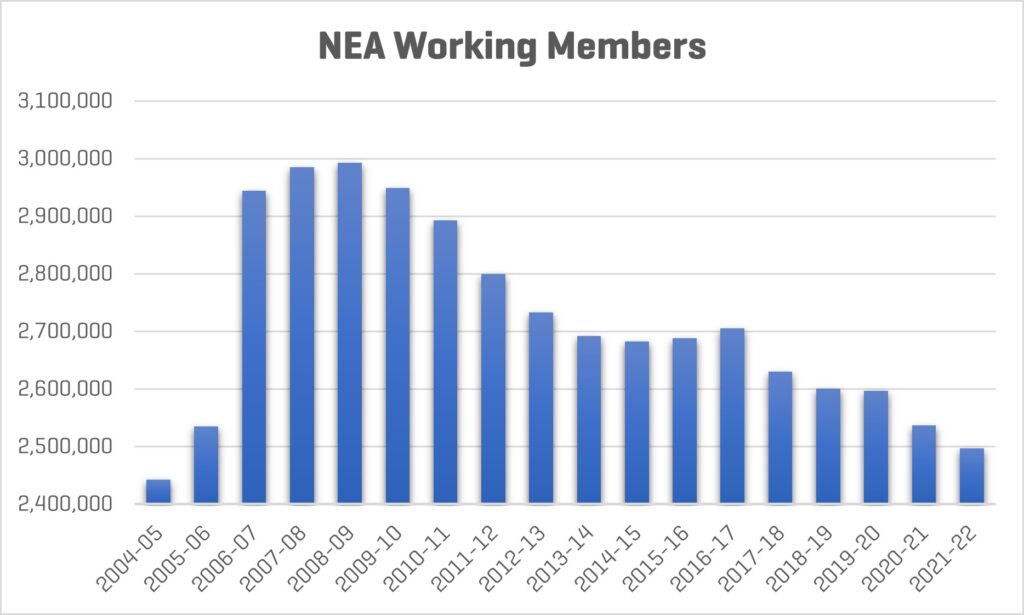
American Federation of Teachers (AFT)
- As the nation’s only other large teachers union, the AFT reported 1,317,434 working members as of June 30, 2018. This includes the following membership categories as listed on AFT’s LM-2 filings: Full, one-half, one-quarter, and one-eighth per-capita taxpayers (“per capita tax” refers to the per-member fee that AFT local affiliates pay to the international headquarters as a condition of affiliation), merged local and state members, and agency fee-payers. It excludes associate, laid off and retiree members. Though the Janus decision was issued a few days prior to the end of the union’s LM-2 reporting period, this must have been too soon to record the loss of agency fee-payers, which was not reflected until AFT’s 2018-19 LM-2.
- As of June 30, 2022, the AFT reported 1,192,252 working members, a decline of 125,182 (9.5 percent), putting the union’s membership at its lowest level since 2014 and erasing the additional growth AFT experienced following its string of mergers with NEA affiliates.
- From a revenue standpoint, AFT has fared comparably to the NEA, bringing in $197 million in the 2017-18 school year and an inflation-adjusted $180 million in 2021-22, a 9 percent decline.
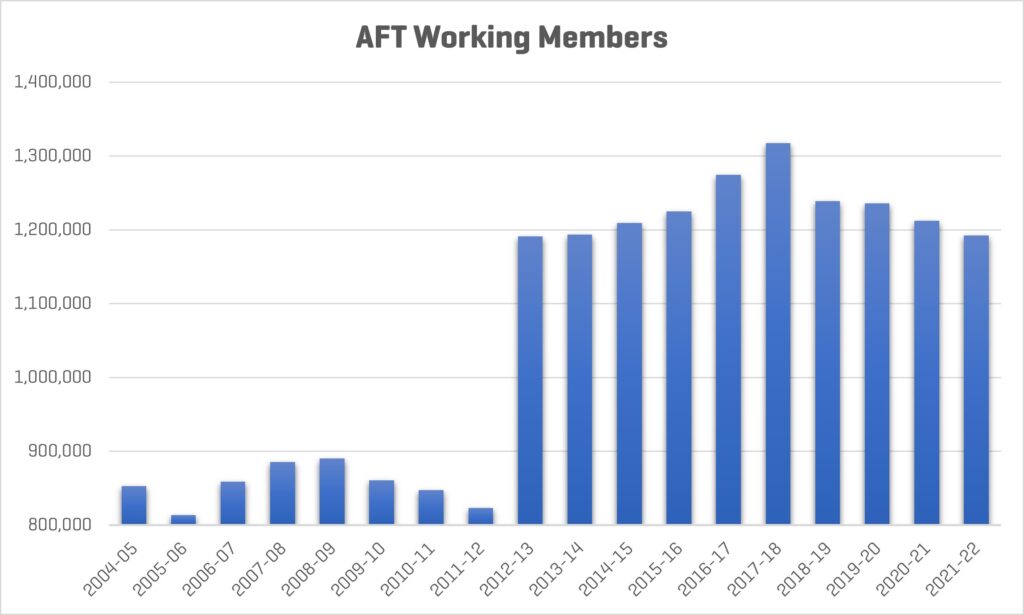
American Federation of State, County and Municipal Employees (AFSCME)
- As its name indicates, AFSCME is generally comprised of all kinds of non-federal public employees.
- Unlike the NEA and AFT, AFSCME represents a consequential number of government-funded home and child care workers covered by the U.S. Supreme Court’s June 2014 ruling in Harris v. Quinn, a precursor to Janus which ended compulsory union dues for “partial” or “quasi” public employees. Following years of declining membership after the Great Recession, AFSCME’s membership had just started to stabilize before Harris, which presaged two more years of decline before another brief stabilization prior to Janus.
- In its last LM-2 filing before Janus, AFSCME reported having 1,256,361 working members as of Dec. 31, 2017, including full-, part-, and half-time members as well as agency fee-payers, but excluding retiree members.
- However, AFSCME reported only 1,051,671 members as of Dec. 31, 2022, a decline of 204,690 (16.3 percent). This is not only the steepest decline of the four unions, but places AFSCME’s membership at the lowest on record.
- If recent trends continue, AFSCME could drop below one million members by the end of 2023.
- Unlike the two teachers’ unions, AFSCME’s revenue from dues, passed up the food chain by its local affiliates, declined 20 percent from $186 million in Dec. 2017 to an inflation-adjusted $148 million in Dec. 2022.
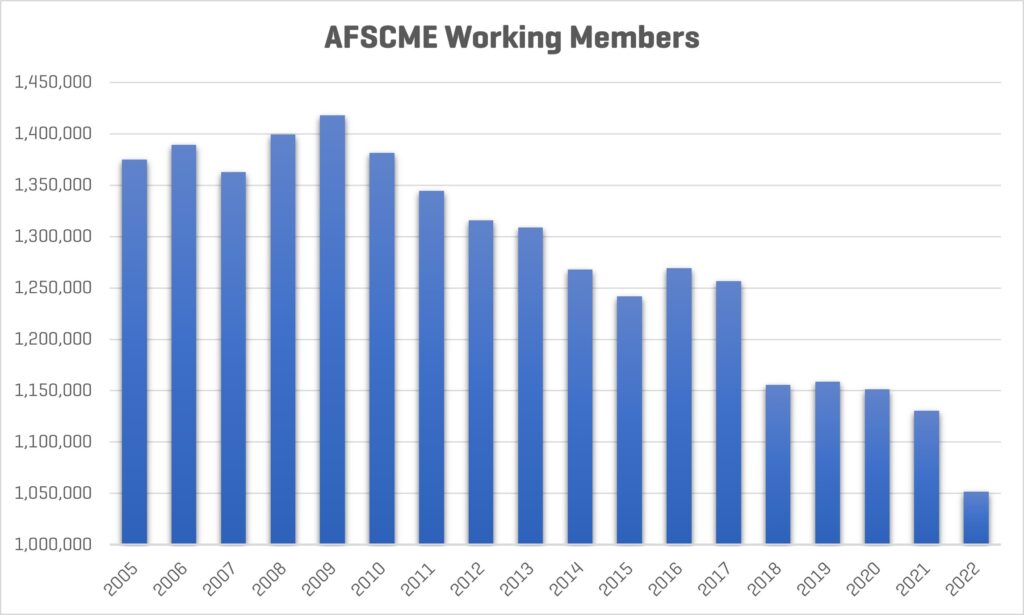
Service Employees International Union (SEIU)
- While a larger segment of SEIU’s membership works in private industry than the other three major government unions, its presence in government remains considerable. SEIU also represents large numbers of partial public employees affected by Harris, and its membership levels have followed the same general pattern as AFSCME’s, just ameliorated somewhat by the union’s significant private-sector membership.
- SEIU reported having 1,990,986 working members nationwide as of Dec. 31, 2017, including regular members and agency fee-payers but excluding retiree members.
- As of Dec. 31, 2022, however, SEIU reported having only 1,790,376 members, a decline of 200,610 (10.1 percent) and the fewest working members the union has reported since 2006.
- In absolute dollars, SEIU’s fortunes have fared worse than the other unions since Janus, with its revenue from dues falling 29 percent from $281 million in 2017 to $199 million in 2022, adjusted for inflation.
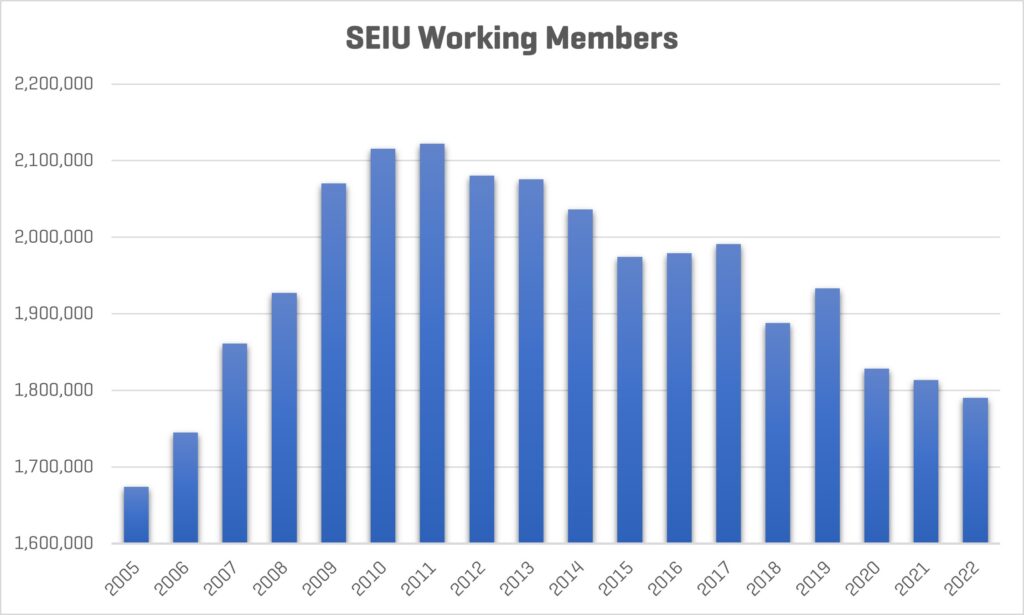
As stark as these declines reported on the unions’ LM-2 forms have been, they don’t capture the full effects of the Janus decision.
First, each of the four unions only has a legal obligation to file annual LM-2 reports with DOL under the Labor-Management Reporting and Disclosure Act because they represent some private-sector members unaffected by Janus. Further, 27 states already had right-to-work laws on the books at the time Janus was decided, so union membership was already optional for public employees in those states.
Consequently, for the unions’ nationwide membership to decline by 10 percent, membership among the portions of its public-sector members affected by Janus would have had to plummet even further, which is precisely what the data show.
For instance, in Washington state, payroll data obtained by the Freedom Foundation show that the percentage of state workers represented by AFSCME Council 28 paying dues has declined from effectively 100 percent in June of 2018 to only 61 percent as of April 2023.
And second, the number of state and local government employees, and potential union members, has continued to grow in recent years—with the exception of a brief pandemic dip—meaning that not only are the unions losing current members, but they’re failing to persuade new employees to join.
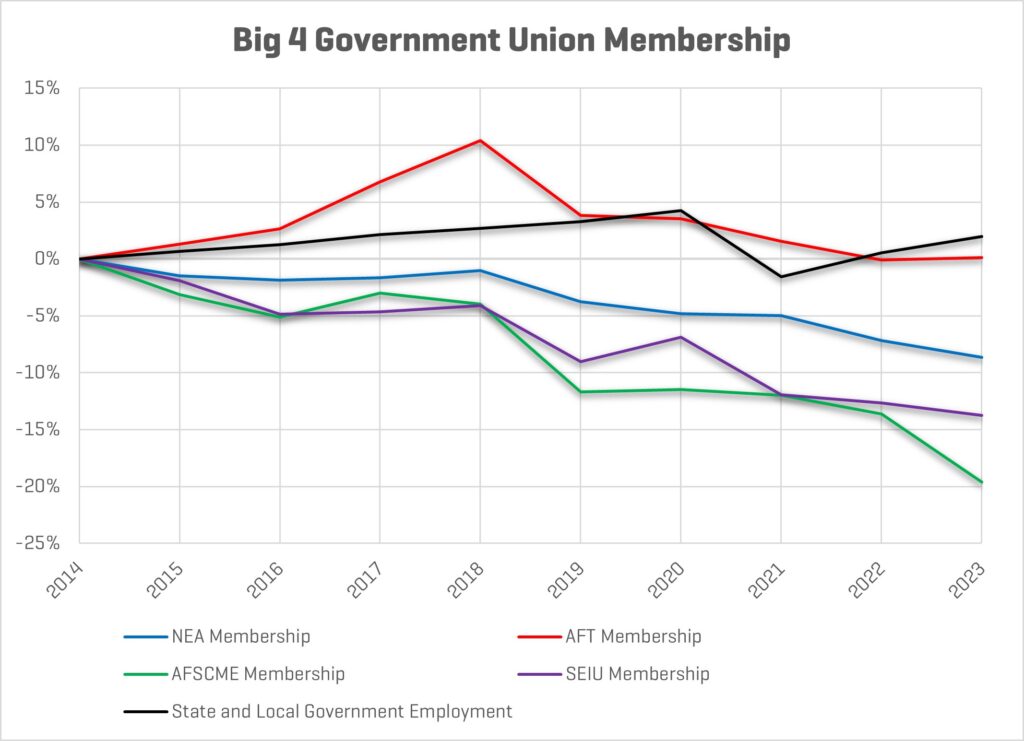
While Janus was far from the “extinction” level event some observers predicted, current trends should have government union executives thinking seriously about how to broaden their appeal.
When confronted with big membership declines a decade ago, unions like the NEA doubled-down on partisan politics. Post-Janus challenges do not appear to have changed the calculus. Instead, unions appear to be gambling that clinging to relevance through coercion, deception, fraud and sheer force of law will keep them afloat.
While such tactics have softened Janus’ impact in the short-term, whether this turns out to be a sustainable long-term strategy remains to be seen.










